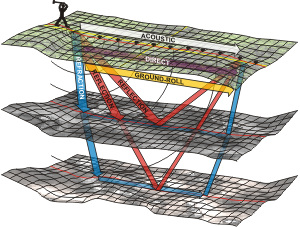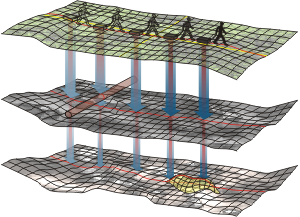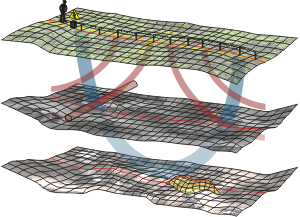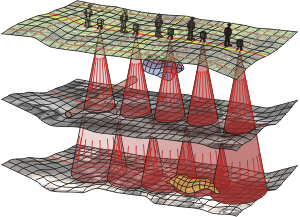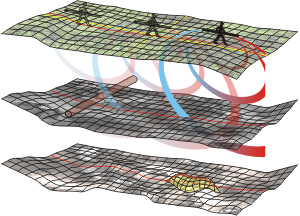Main Page | Knowledge base | Geophysics
GEOPHYSICS
Geophysics, by using the laws of physics, gives the answer of the nature, structure and parameters of soils and rocks. Another important advantage is to gather this information in continuous and non-invasive way (without drilling, geological works). In other words, geophysical surveys allow you continuous mapping of structural changes and geomechanical parameters in the ground.
The most common methods of engineering geophysics:
Engineering seismic method
Analysis of artificially generated seismic waves in the ground and rocks. These waves passing through the inhomogeneous medium are subject to refraction, reflection, diffraction phenomena. Any disturbance in the structure and properties of soil (e.g. a change in density, fracturing, weathering, fault) affects the parameters like the seismic waves velocity or attenuation. This method is used for the determination of: geological boundaries, bedrock (e.g. in quarries), rippability, discontinuities, groundwater levels, density, subsidences, cavities, karst forms, underground objects.
Georadar method GPR
Analysis of electromagnetic wave propagation in the medium. These waves passing through the inhomogeneous medium are subject different phenomena, eg refraction reflection, diffraction. Analysis of the reflected signal interference enables the location of objects and observations of structural changes. GPR method is used to detect geological and geotechnical boundaries, ground subsidence, cavities, detection of underground objects, searching infrastructure such as cables, pipes (including PVC) or collectors.
Resistivity method DC
Analysis of the propagation of electric current in the ground, based on the determination of changes in ground physical parameter of the test which is electrical resistivity (resistivity). These changes are caused by objects of natural (geological) or anthropogenic (as a result of human activity). DC method is used for: detection of geological and geotechnical boundaries (e.g. directional drilling HDD), changes in ground resistance, watertable, range of contamination areas, pollution, detection of underground objects.
Gravimetric method
Analysis of changes in the Earth’s gravity generating gravity anomalies that are caused by non-uniform distribution of masses of rock in the ground. This method is used to determine areas of weakness & loosening, and in particular the detection of voids. The most common is the location of voids resulting from mining and shallow karst phenomena, detection of unreported and nonliquidated wells, shafts, adits. In addition, such studies are designed to detect the underground spaces like military fortifications, cellars, chambers, tunnels and corridors, as well as underground catacombs, crypts and tombs.
Electromagnetic method
Analysis of the electromagnetic field artificially induced in the ground. Analysis of recorded signal enables the detection of changes in the conductivity of the ground, outlining coverage of contamination&pollutions, localization of the increased filtration or leaks, detection of underground collectors, tunnels.
Each of these methods uses different geophysical phenomena and are used depending on the task, and each methods limitations. Measurements are carried out using specialized equipment and field data require sophisticated analysis through signal processing, interpretation and visualization of results in the form of geophysical profiles, cross-sections, maps.
Wide range of applications of geophysical methods means that they are very helpful in geotechnical studies, geological, natural environment protection and in many fields such as mining, water and land construction. Application examples of engineering geophysics.
Geophysical studies with seismic, resistivity and GPR methods are commonly recommended in many standards (ASTM), acts, regulations.



